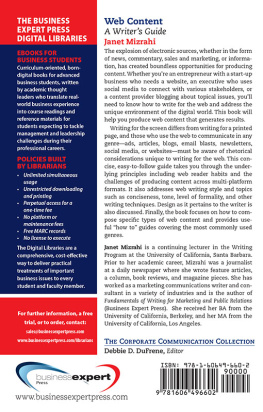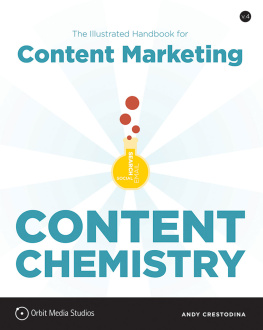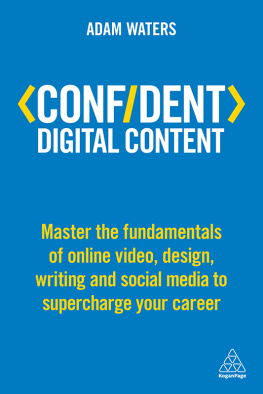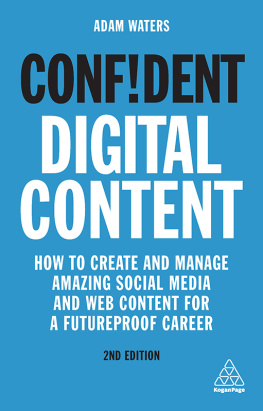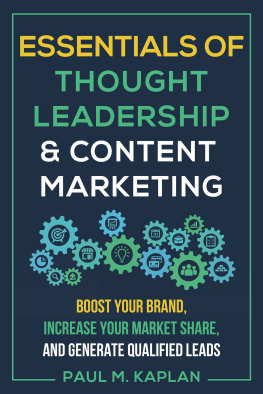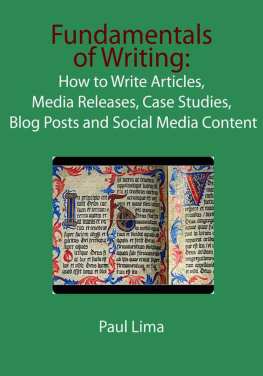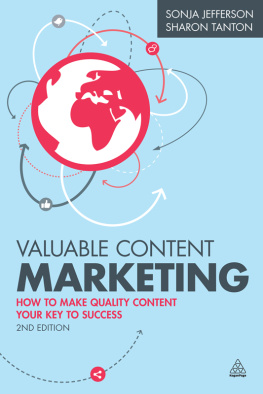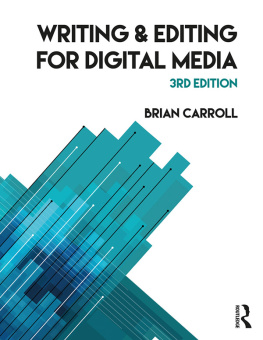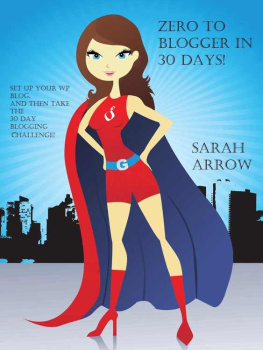Web Content
Web Content: A Writers Guide
Janet Mizrahi

Web Content: A Writers Guide
Copyright Business Expert Press, 2013.
All rights reserved. No part of this publication may be reproduced, stored in a retrieval system, or transmitted in any form or by any meanselectronic, mechanical, photocopy, recording, or any other except for brief quotations, not to exceed 400 words, without the prior permission of the publisher.
First published in 2013 by
Business Expert Press, LLC
222 East 46th Street, New York, NY 10017
www.businessexpertpress.com
ISBN-13: 978-1-60649-660-2 (paperback)
ISBN-13: 978-1-60649-661-9 (e-book)
Business Expert Press Corporate Communication collection
Collection ISSN: 2156-8162 (print)
Collection ISSN: 2156-8170 (electronic)
Cover and interior design by Exeter Premedia Services Private Ltd.
Chennai, India
First edition: 2013
10 9 8 7 6 5 4 3 2 1
Printed in the United States of America.
To my girls, Caroline and Jessicadefinitely my best work products.
Abstract
The explosion of electronic sources, whether in the form of news, commentary, sales and marketing, or information, has created boundless opportunities for producing content. Whether the author is an entrepreneur with a start-up business who needs a website, an executive who uses social media to connect with various stakeholders, or a content provider blogging about topical issues, writers for the web must address the unique environment of the digital world. This book will help writers of all levels produce web content that generates results.
Writing for the screen differs from writing for a printed page, and those who use the web to communicate in any genreads, articles, blogs, email blasts, newsletters, social media, or websitesmust be aware of rhetorical considerations unique to writing for the web. This concise, easy-to-follow guide takes the reader through the underlying principles that make writing for the web unique, including web reader habits and the challenges of producing content across multi-platform formats. It addresses web writing style and topics such as conciseness, tone, level of formality, and other writing techniques. Design as it pertains to the writer is also discussed. Finally, the book focuses on how to compose specific types of web content and provides useful how to guides covering the most commonly used genres.
Keywords
web content, web copy, digital content, web writing, content provider, web communication, web text, online writing, content development, internet content provider.
Contents
Not too long ago, I spent the better part of a week cruising the web. I dont even remember what I was originally looking for, but I recall seeing a phrase over and overcontent provider. I had first heard the term from a Los Angeles Times reporter, who was ruing her new title. She used to be a staff writer, she told me, a reporter. Now the publisher expected her to provide content. Part of that task was not only turning in news articles and featuresnow she had to write a blog. I filed away the information and thought no more about it.
But the week that I continually came upon the job title of content provider, I decided to look into what it meant more carefully. So many of my students are desperate for direction about what to do after graduation that I thought I could talk to them about becoming content providers. The more I investigated, the clearer it became: Providing content meant being a writer, more specifically, a versatile writer who was conversant in the various genres that appear on the web.
Not long after, I decided to write a condense book that students and businesspeople could turn to as a guide to the best practices for writing web content. And that was the genesis of this work. My goal is to provide the information and background necessary for you to confidently write in the many different genres we find on the web. From the individual who wants to create a controlled web identity by having a professional website to employees within organizations charged with writing website copy or other types of content found on the web to managers who are responsible for their organizations web presence, this book is designed to help you write effectively.
Exhibits
Writing well as a professionalwhether it is for print or the screen is best taken on as a process, with careful attention paid to detail. This chapter will describe how to break down all writing tasks into a series of steps to streamline the process as well as describe the characteristics that all professional writing should embody.
Writing as a Process
Whatever we are composingwhether an email message or a website the key to writing well is to consider writing a process rather than a one-shot deal. Your prose will be better and will take you less time to compose if you look at writing as a series of tasks. For those who suffer from writers block or who shudder at the thought of writing, I can promise that if you break down writing into several component parts, the result will be better and you will feel less anxious.
The task of writing can be broken down to three separate steps, for which Ive developed an acronym: AWE , short for Assess, Write, Edit. These three steps should be completed for every piece of writing that will be seen by another person. The only writing that doesnt require this process is writing for your eyes only.
Step 1: Assess
Before you ever put your fingers to the keyboard or take pen to paper, begin by assessing the writing situation and define your audience and purpose. I advise making this step formal: Write down your answers.
Knowing the audienceyour readeris imperative for successful writing. Writers need to be very clear about the end user because the language and style we use depends upon who will read what we write. In essence, we have to psych out the reader to accomplish our writing goal. We cannot do that unless we analyze the reader accurately. Define the characteristics about your reader as follows.
However, as web writers, we have to take defining of our audience even further. Web content is designed for a broad audience (such as the audience for cnn.com) or a specific and narrow audience (such as a site geared to cardiac surgeons or IT specialists). And while all web readers share the expectation that they will be able to access information fast, readerships vary greatly. A detailed readers profile will help a web writer create content that will be more successful in attracting and keeping readers.
Begin the audience analysis portion of the first stage of the writing process (assessing) by completing the Audience Profile table in using the facts you gather about your readership.
Audience characteristic | Rationale |
|---|
Age | Writing for children differs from writing for adults or teens. Your tone, word choice, and medium may differ greatly depending on the age of the reader. |
Gender | Writing for an all-male audience will differ from writing for an all-female audience. Likewise, if the audience is mixed, you may make different language choices than you do for a homogeneous group. |
Language proficiency | The readers knowledge of English will affect your word choice, sentence length, and other stylistic elements. |

